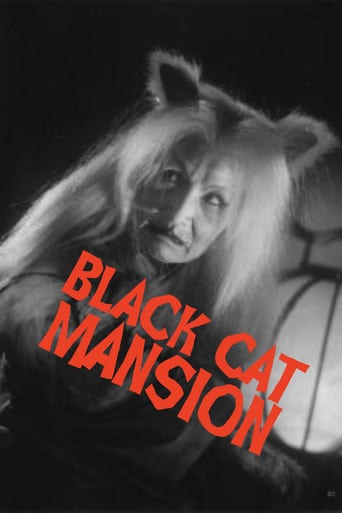SnakesOnAnAfricanPlain
The film starts off as a blue and white film. There is a hideous blue tint, making this seem so amateurish. Luckily these scenes only bookend a rather mesmerizing middle. As the story is recounted, we see an absolute arse faced samurai, let his temper get the better of him. This soon leads to murder, which leads to suspicion, followed by rape, and then madness. The story is creepy at times, but when the cat/ghost woman has cat ears pop-up on top of her head, it's rather a funny sight. I never felt threatened by the "horror" on screen. It seemed at times as though the middle section was made and just wasn't enough for a motion picture, resulting in the poorly assembled present day sequences. The film's running time works in its favor, but the period piece certainly could have made a longer film, if it bothered to deal with the descent into madness and the horrific acts gradually increasing.
Chung Mo
Director Nakagawa's "Jigoku" is probably one of his most famous films from a career that started in the 1930s and improbably ended with the proto pinku Okatsu series in 1969. He directed one more film 13 years later before his death in 1984. "Black Cat Mansion" or "Mansion of the Ghost Cat" is sort of in the middle and continues the ghost and horror genre he specialized in after World War II.A doctor and his sick wife move to the countryside so she may recuperate. They move into a long unused samurai mansion owned by her family. It's the 1950's and the doctor is a rational minded person. He scoffs at his wife's skittishness in the creepy old house. One rainy day a creepy old woman arrives to the clinic the doctor has opened in part of the mansion. She attempts to strangle the wife but disappears once the doctor shows up at the sound of his wife's screams. Even though the nurse has seen the old woman also, the doctor can't believe that there even was an old woman because he didn't see her. Things get worse and the doctor learns about the legend of the mansion from a Buddhist priest. Here we see the story of the ill-tempered samurai lord and the Go master.Dark and moody with a creepy, tension filled music track, this movie is effective on many levels. Nakagawa's previous experience with ghost stories is apparent as he handles the creepy factor very well. The modern day sequences are shot in black and white while the legend is shot in color. Most of the film is very well done and really lays on the atmosphere until the vengeful cat spirit gets to work. Unfortunately the film makers rely on Kabuki theater techniques too much and unlike the rest of the film these scenes are over lit so when the cat demon raises it's ears in attack, instead of being terrified you are immediately reminded of the Cowardly Lion from Wizard of Oz. A strange sequence where the cat demon makes a servant girl do acrobatic flips on and off a porch before it kills her really kills the mood. In between these scenes are effective horror. Later the movie returns to present day and the great black and white cinematography.Only 67 minutes long the film is a mixed bag. I enjoyed it but the very stagy cat demon might make this a disappointment for other viewers.
Watuma
The Mansion of the Ghost Cat shows the misdeeds of a prior generation not only bringing suffering and death to that generation's members, but also threatening their blameless descendants. Ghosts are put to rest only when the misdeeds are brought to light and treated properly. In the context of post-war Japanese society (a `house' haunted by the past), the message of Nobuo Nakagawa's third ghost film is hard to ignore.Viewed simply as a ghost story, the film includes several creepy sequences. In a darkened hospital corridor, a sheet-draped body is wheeled silently by a masked figure. During the first visit to the derelict mansion, a woman with a shock of white hair is glimpsed churning butter. A wall disintegrates at the height of a thunderstorm, revealing an alcove, and a rotting corpse slowly topples out. Unfortunately, much of the sinister atmosphere dispels whenever the cat spirit itself appears, particularly when its furry ears pop up.The film is structured differently from any of Nakagawa's previous work. The opening and closing sections have a contemporary setting and are acted naturalistically. The lengthy middle section is set in the previous century and presented more impressionistically, once again showing the strong influence on the director of kabuki theatre. Unusually, the flashback is filmed in colour, and is therefore more vivid than the modern-day monochromatic bookends.Nakagawa seems to have seized on the opportunity for technical experimentation, too, although not always successfully. This is the first film he made in scope, but the compositions rarely take full advantage of the broader screen. More effective is the use of colour, with pastel shades predominating for costumes and settings, in order to heighten the dramatic impact of the sudden appearance of blood. A number of sequences try out dramatic lighting effects, such as the dimming of the light level just before ghosts appear and the use of silhouettes. Towards the end of the middle section, there's a montage sequence that's Nakagawa's first attempt to use editing for dramatic effect. And, of course, he continues to experiment with the innovative and sometimes startling camera moves that characterize all his films.The Mansion of the Ghost Cat represents the director's evolution to a more sophisticated level of filmmaking, both in theme and technique. It contains the seeds that would later blossom into his most famous work, Jigoku.



